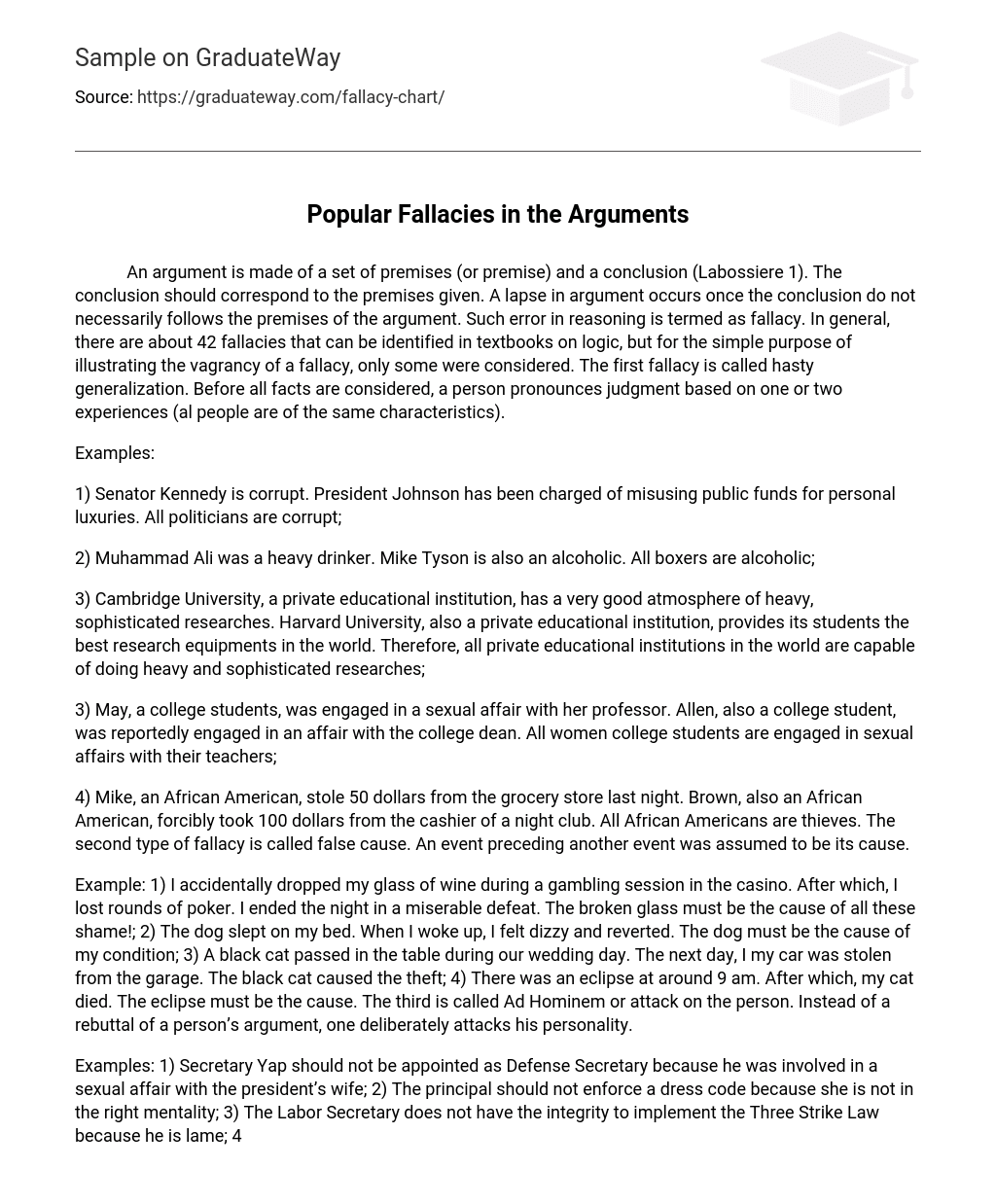An argument is made of a set of premises (or premise) and a conclusion (Labossiere 1). The conclusion should correspond to the premises given. A lapse in argument occurs once the conclusion do not necessarily follows the premises of the argument. Such error in reasoning is termed as fallacy. In general, there are about 42 fallacies that can be identified in textbooks on logic, but for the simple purpose of illustrating the vagrancy of a fallacy, only some were considered. The first fallacy is called hasty generalization. Before all facts are considered, a person pronounces judgment based on one or two experiences (al people are of the same characteristics).
Examples:
1) Senator Kennedy is corrupt. President Johnson has been charged of misusing public funds for personal luxuries. All politicians are corrupt;
2) Muhammad Ali was a heavy drinker. Mike Tyson is also an alcoholic. All boxers are alcoholic;
3) Cambridge University, a private educational institution, has a very good atmosphere of heavy, sophisticated researches. Harvard University, also a private educational institution, provides its students the best research equipments in the world. Therefore, all private educational institutions in the world are capable of doing heavy and sophisticated researches;
3) May, a college students, was engaged in a sexual affair with her professor. Allen, also a college student, was reportedly engaged in an affair with the college dean. All women college students are engaged in sexual affairs with their teachers;
4) Mike, an African American, stole 50 dollars from the grocery store last night. Brown, also an African American, forcibly took 100 dollars from the cashier of a night club. All African Americans are thieves. The second type of fallacy is called false cause. An event preceding another event was assumed to be its cause.
Example: 1) I accidentally dropped my glass of wine during a gambling session in the casino. After which, I lost rounds of poker. I ended the night in a miserable defeat. The broken glass must be the cause of all these shame!; 2) The dog slept on my bed. When I woke up, I felt dizzy and reverted. The dog must be the cause of my condition; 3) A black cat passed in the table during our wedding day. The next day, I my car was stolen from the garage. The black cat caused the theft; 4) There was an eclipse at around 9 am. After which, my cat died. The eclipse must be the cause. The third is called Ad Hominem or attack on the person. Instead of a rebuttal of a person’s argument, one deliberately attacks his personality.
Examples: 1) Secretary Yap should not be appointed as Defense Secretary because he was involved in a sexual affair with the president’s wife; 2) The principal should not enforce a dress code because she is not in the right mentality; 3) The Labor Secretary does not have the integrity to implement the Three Strike Law because he is lame; 4) The president will not be able to govern us because he doesn’t have a Ph. D degree. The fourth is called either-or thinking. The person posits only two alternatives even if the condition is more complex from what it appears.
Examples: 1) President Bush said, “Either you are an enemy of the coalition or an ally”; 2) If you are not my friend, then you are my enemy; 3) Either you pay your debt or be imprisoned; 4) Either you are good in Math or in English. The fifth is called slippery slope. A person predicts an undesirable event from a given events without the support of evidences.
Example: 1) Many elders will die if the prices of medicines continue to rise; 2) If we ban death penalty, the crime rate will go up; 3) If divorce will be banned by the government, cohabitation will inevitably increase; 4) If the government bans poker, it will also ban other games of chance. The sixth is called begging the question. This can be described as circular reasoning.
Examples: 1) Importation of labor is bad because it disrupts our economy; 2) Men should not be admitted to sororities because they are for women only. The last is called straw man. This consists of an attack similar but not the same as what your opponent holds. Examples: The ombudsman was accused of receiving bribes from businessmen. He argued that he cannot accept bribes because he was already rich; 2) The senate pro-tempore accused the vice-president of corroborating with the minority party to increase his popularity. He admitted the accusation although he argued that he only wanted to play golf with the minority senators.
Work Cited
Labossiere, Michael C. The Nizkor Project: Fallacies. In http://www.nizkor.org/features/fallacies/. Retrieved July 29, 2007.





